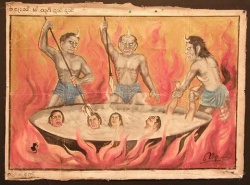Hell
hell
地獄 (Skt, Pali naraka or niraya; Jpn jigoku )
The first and lowest of the three evil paths, the six paths, and the Ten Worlds. Buddhist scriptures describe various kinds of hells, such as the eight hot hells and the eight cold hells. They depict hell as a realm beneath the earth where those who have committed evil are reborn and undergo different degrees of suffering for varying periods of time according to the nature and weight of their offenses. The expression "136 hells" is used to describe the array of hells, this number representing the eight hot hells, each with its six-teen subsidiary hells. T'ient'ai (538-597) and Nichiren (1222-1282) interpreted hell, or any other of the Ten Worlds, as a condition inherent within life and manifest at any moment. Viewed in this manner, hell describes a condition of utmost suffering and despair. See also eight cold hells; eight hot hells.
Suffering is most severe, continuous and everlasting. Those beings must have committed unforgivable and evil deed, with no regret or repent. The evil karma determines their existence in hell. They suffer until they are completely retributed or the evil karma vanishes. However, for those who committed the Five Offences (deadly sins), they will stay in hell without any specific time to be liberated.
The five rebellious acts or deadly sins are:
- killing one's father
- killing one's mother
- killing an Arhat
- shedding the Buddha's blood
- creating disharmony among the Sangha.
The performance of good or bad deeds, symbolise one's ascending to the heavens or descending to Hell under the law of karma. It is not the judgement of any Buddhas or gods, nor is it the judgement of any Supreme God; it is in respect to everyone's wishes and it manifests accordingly. In the eyes of the good people there is no Hell, because they do not have karma with it. In the eyes of the bad people, there is a manifestation of Hell, because Hell is the manifestation of their minds. Simply, it is one's own conscience punishing one's own sins.
The sufferings of Hell include unlimited coming alive and dying within a single day. The hell that has the most suffering is the Avici Hell. The suffering of Avici Hell is clearly described in the Ksitigarbha Sutra. The first suffering is uninterrupted time, meaning there is no rest. The suffering is continuous, there is no respire for even one minute or one second. The second suffering is uninterrupted space. In Avici Hell, space is filled with one or many persons. If there is a lot of space, a person will multiply himself until he occupies all the space. So this hell can be full with only one person. The third is uninterrupted suffering. One has to suffer all the kinds of suffering in the world. There is no hell which has more suffering than this Avici Hell. Such suffering is called unlimited suffering. The fourth suffering is uninterrupted grade, meaning this hell does not differentiate, whether one is a god in heaven, a human in the human realm, a hungry ghost within the ghost realm or an animal within the animal realm. If one "qualified", anyone can enter Avici Hell and receive the same treatment. The fifth suffering is uninterrupted life. There are numerous lives and deaths within a day and a night, and, between one life and one death, one suffers.
